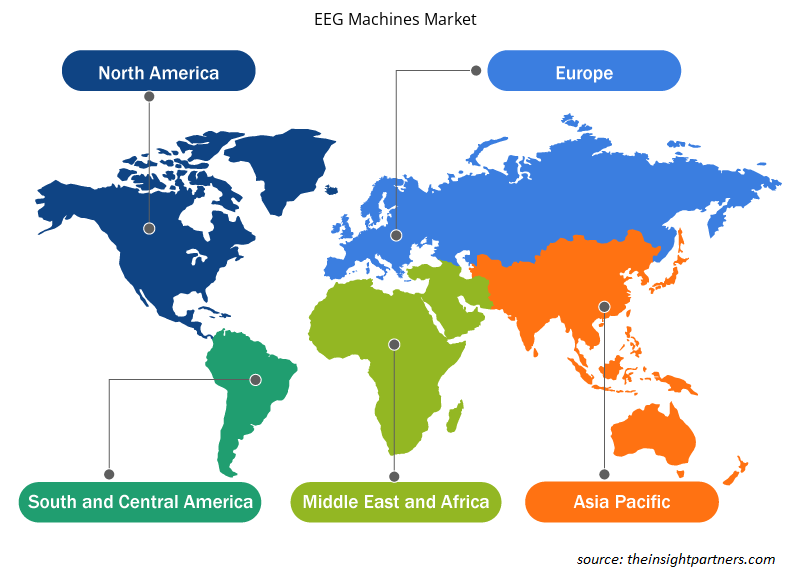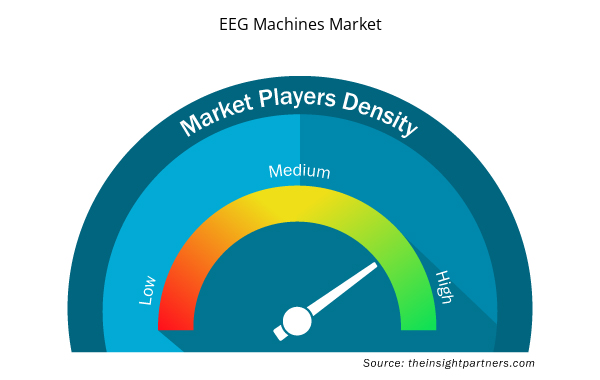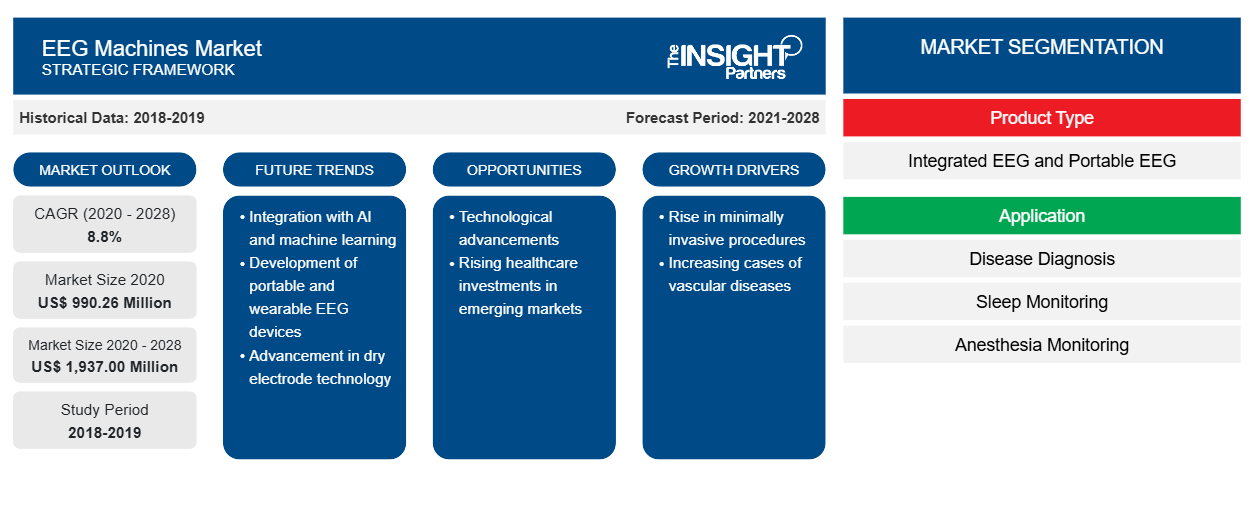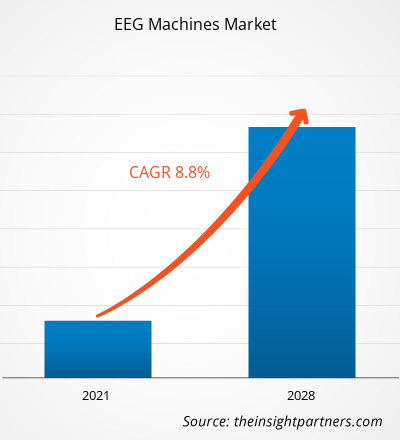[연구 보고서] EEG 장비 시장은 2020년에 9억 9,026만 달러 규모로 평가되었으며, 2028년까지 19억 3,700만 달러에 도달할 것으로 예상됩니다. 2021년에서 2028년까지 연평균 성장률 8.8%로 성장할 것으로 예상됩니다.
뇌파(EEG) 기계는 의료 전문가가 뇌의 전기 신호를 모니터링하는 데 도움이 되는 의료 기기입니다. 전송되는 전기 신호는 비교적 약하기 때문에 증폭이 필요합니다. 증폭기는 전압을 확대하는 데 사용됩니다. EEG 장치의 판독값은 다양한 신경계 장애를 진단하고 수술과 같은 의료 시술 중에 수면 장애와 마취 중인 환자를 모니터링하는 데 사용됩니다. 이 장비는 두피에 부착된 전극의 도움으로 뇌파의 판독값을 수집합니다. EEG 기계는 주로 병원, 진단 실험실 및 외래 수술 센터에서 사용됩니다.
EEG 기계 시장은 제품 유형, 응용 프로그램, 최종 사용자 및 지역에 따라 세분화됩니다. 지역은 북미, 유럽, 아시아 태평양, 중동 및 아프리카, 남미 및 중미로 세분화됩니다. 이 보고서는 시장 동향, 기술 발전, 시장 역학 및 전 세계 주요 시장 참여자의 경쟁 환경 분석과 같은 다양한 매개변수를 강조하여 EEG 기계 시장에 대한 통찰력과 심층 분석을 제공합니다. 또한 모든 지역에 대한 COVID-19 영향 분석도 포함되어 있습니다. COVID-19 팬데믹으로 인해 제한된 건강 서비스와 봉쇄 상황으로 인해 예측 기간 동안 시장 성장률이 더 느릴 것으로 추정됩니다.
귀하의 요구 사항에 맞게 이 보고서를 사용자 정의하세요
이 보고서의 일부 또는 국가 수준 분석, Excel 데이터 팩을 포함하여 모든 보고서에 대한 사용자 정의를 무료로 받을 수 있으며 신생 기업 및 대학을 위한 훌륭한 혜택과 할인 혜택을 이용할 수 있습니다.
- 이 보고서의 주요 시장 동향을 알아보세요.이 무료 샘플에는 시장 동향부터 추정 및 예측까지 다양한 데이터 분석이 포함됩니다.
시장 통찰력
신경계 질환의 증가
노인들 사이에서 신경계 질환의 발병률이 증가하고 있습니다. 그러나 스트레스, 유전적 돌연변이, 생활 습관 및 관련 만성 질환과 같은 다양한 요인으로 인해 모든 연령대의 사람들에게 발병률이 나타납니다. 신경계 질환은 600개가 넘는 것으로 추정되며, 그 중 파킨슨병, 헌팅턴병, 알츠하이머병, 근위축증, 뇌졸중, 뇌막염, 간질, 치매, 편두통 및 뇌종양이 흔히 나타납니다.
JAMA Neurology 2017에 발표된 Global Burden of Disease 보고서에 따르면, 뇌졸중, 편두통, 알츠하이머병 및 기타 치매와 같은 대부분의 부담스러운 질병에 대한 장애 조정 생명 연수(DALY)가 미국에서 연구되었습니다. 뇌졸중의 DALY는 358만, 알츠하이머병 및 기타 치매의 경우 255만, 편두통의 경우 240만이었습니다. 뇌막염(44.8%), 외상성 뇌 손상(44.8%), 척수 손상(29.1%), 뇌염(38.5%)의 발생률로 인해 앞으로 발생률이 증가할 것으로 추산됩니다.
마찬가지로, 노령 인구의 증가는 신경계 질환의 발생에 영향을 미칠 것으로 예상됩니다. 2018년에 발표된 세계보건기구(WHO) 보고서에 따르면, 60세 이상의 총 인구는 2015년 12%에서 2050년까지 22%의 비율로 증가할 것입니다. 2016년에 발표된 노령 관련 통계에 대한 연방 기관 간 포럼에 따르면, 85세 이상의 35.8%가 중간 또는 심각한 기억 장애를 가지고 있습니다. 따라서 위에서 언급한 통계로 인해 EEG 기계에 대한 수요가 증가할 것으로 예상되며, 이는 차례로 시장 성장을 촉진할 것입니다.
제품 유형 기반 통찰력
제품 유형에 따라 EEG 기계 시장은 통합 EEG와 휴대용 EEG로 세분화됩니다. 통합 EEG 세그먼트는 2020년에 시장에서 가장 큰 점유율을 차지했습니다. 그러나 휴대용 EEG 세그먼트는 예측 기간 동안 시장에서 가장 높은 CAGR을 기록할 것으로 예상됩니다. 휴대용 EEG 세그먼트의 성장은 비교적 저렴하고 비침습적인 실시간 뇌 활동을 제공하는 기술 발전에 기인할 수 있습니다.
애플리케이션 기반 통찰력
응용 프로그램을 기준으로 EEG 기계 시장은 질병 진단, 수면 모니터링, 마취 모니터링, 외상 및 수술 등으로 세분화됩니다. 질병 진단 부문은 2020년에 시장에서 가장 큰 점유율을 차지했으며, 또한 이 부문은 예측 기간 동안 시장에서 가장 높은 CAGR을 기록할 것으로 예상됩니다.
최종 사용자 기반 통찰력
최종 사용자를 기준으로 EEG 기계 시장은 병원, 진단 센터, 외래 수술 센터, 연구실 등으로 세분화됩니다. 병원 부문은 2020년에 시장 점유율이 가장 높았지만, 진단 센터 부문은 예측 기간 동안 시장에서 가장 높은 CAGR을 기록할 것으로 예상됩니다.
유기적 및 무기적 전략은 시장 참여자들이 변화하는 고객 수요를 충족하고 개선된 서비스를 유지하기 위해 동등하게 채택했습니다. 예를 들어, Fresenius Kabi는 2021년 2월에 유기적 확장 전략을 채택했습니다. 이 회사는 생명에 대한 보살핌이라는 회사의 철학에 따라 중증 및 만성 질환 환자를 돌보는 데 도움이 되는 전 세계 시설의 발전에 투자했습니다. 또한 Fresenius Kabi는 그라츠의 두 시설에 계속 투자했습니다.
EEG 기계 시장 지역 통찰력
Insight Partners의 분석가들은 예측 기간 동안 EEG 기계 시장에 영향을 미치는 지역적 추세와 요인을 철저히 설명했습니다. 이 섹션에서는 북미, 유럽, 아시아 태평양, 중동 및 아프리카, 남미 및 중미의 EEG 기계 시장 세그먼트와 지리에 대해서도 설명합니다.

- EEG 기계 시장에 대한 지역별 데이터 얻기
EEG 기계 시장 보고서 범위
| 보고서 속성 | 세부 |
|---|---|
| 2020년 시장 규모 | 9억 9,026만 달러 |
| 2028년까지 시장 규모 | 1,937.00백만 달러 |
| 글로벌 CAGR (2020-2028) | 8.8% |
| 역사적 데이터 | 2018-2019 |
| 예측 기간 | 2021-2028 |
| 다루는 세그먼트 | 제품 유형별
|
| 포함된 지역 및 국가 | 북아메리카
|
| 시장 선도 기업 및 주요 회사 프로필 |
|
EEG 기계 시장 참여자 밀도: 비즈니스 역학에 미치는 영향 이해
EEG 머신 시장 시장은 소비자 선호도의 변화, 기술 발전, 제품의 이점에 대한 인식 증가와 같은 요인으로 인해 최종 사용자 수요가 증가함에 따라 빠르게 성장하고 있습니다. 수요가 증가함에 따라 기업은 제품을 확장하고, 소비자의 요구를 충족하기 위해 혁신하고, 새로운 트렌드를 활용하여 시장 성장을 더욱 촉진하고 있습니다.
시장 참여자 밀도는 특정 시장이나 산업 내에서 운영되는 회사나 기업의 분포를 말합니다. 주어진 시장 공간에 얼마나 많은 경쟁자(시장 참여자)가 존재하는지 그 규모나 총 시장 가치에 비해 나타냅니다.
EEG 기계 시장에서 운영되는 주요 회사는 다음과 같습니다.
- 코닌클리크 필립스 NV
- 메드트로닉
- 나투스 메디컬 주식회사
- 니혼코덴 주식회사
- 프레세니우스 SE & Co. KGaA
면책 조항 : 위에 나열된 회사는 어떤 특별한 순서에 따라 순위가 매겨지지 않았습니다.

- EEG 기계 시장 주요 주요 업체 개요를 알아보세요
제품 유형별
- 통합 EEG
- 휴대용 EEG
응용 프로그램으로
- 질병 진단
- 수면 모니터링
- 마취 모니터링
- 외상 및 수술
- 기타
최종 사용자별
- 병원
- 진단 센터
- 외래 수술 센터
- 연구실
- 기타
지리별로
북아메리카
- 우리를
- 캐나다
- 멕시코
유럽
- 프랑스
- 독일
- 이탈리아
- 영국
- 스페인
- 유럽의 나머지 지역
아시아 태평양(APAC)
- 중국
- 인도
- 대한민국
- 일본
- 호주
- APAC의 나머지 지역
중동 및 아프리카(MEA)
- 남아프리카 공화국
- 사우디 아라비아
- 아랍에미리트
- MEA의 나머지
남미 및 중미(SCAM)
- 브라질
- 아르헨티나
- 나머지 SCAM
회사 프로필
- 코닌클리크 필립스 NV
- 메드트로닉
- 나투스 메디컬 주식회사
- 니혼코덴 주식회사
- 프레세니우스 SE & Co. KGaA
- 고급 뇌 모니터링
- D & DJ 버튼 홀딩스
- 세팔론 A/S
- 캐드웰 인더스트리 주식회사,
- 뉴로스타일 주식회사
- 역사적 분석(2년), 기준 연도, CAGR을 포함한 예측(7년)
- PEST 및 SWOT 분석
- 시장 규모 가치/양 - 글로벌, 지역, 국가
- 산업 및 경쟁 환경
- Excel 데이터 세트



Report Coverage
Revenue forecast, Company Analysis, Industry landscape, Growth factors, and Trends

Segment Covered
This text is related
to segments covered.

Regional Scope
North America, Europe, Asia Pacific, Middle East & Africa, South & Central America

Country Scope
This text is related
to country scope.
자주 묻는 질문
Key factors that are driving growth of the market are increasing product launches, increasing neurological disorders. Whereas high cost and disadvantages of EEG machines are key factors restraining the market growth.
The cost of the EEG machines is divided in three major price ranges: lower price range (US$ 99–US$1,000), middle price range (US$1,000–US$25,000), and upper price range (US$25,000+).
An electroencephalography (EEG) machine is a medical device that helps medical professionals monitor the brain's electrical signals. The electrical signals transmitted are relatively weak and thus require amplification. An amplifier is used to magnify the voltage. An EEG device's readings are utilized to diagnose various neurological disorders and monitor sleep disorders and patients under anesthesia during medical procedures such as surgery. The equipment works with the help of electrodes attached to the scalp to collect the brain wave's reading. EEG machine is mostly used in hospitals, diagnostic laboratories, and ambulatory surgery centers.
Trends and growth analysis reports related to Life Sciences : READ MORE..
The List of Companies - EEG Machines Market
- Koninklijke Philips N.V.
- Medtronic
- Natus Medical Incorporated
- Nihon Kohden Corporation
- Fresenius SE & Co. KGaA
- Advanced Brain Monitoring
- D & DJ BURTON HOLDINGS
- Cephalon A/S
- Cadwell Industries Inc
- NeuroStyle Ptd. Ltd.
The Insight Partners performs research in 4 major stages: Data Collection & Secondary Research, Primary Research, Data Analysis and Data Triangulation & Final Review.
- Data Collection and Secondary Research:
As a market research and consulting firm operating from a decade, we have published and advised several client across the globe. First step for any study will start with an assessment of currently available data and insights from existing reports. Further, historical and current market information is collected from Investor Presentations, Annual Reports, SEC Filings, etc., and other information related to company’s performance and market positioning are gathered from Paid Databases (Factiva, Hoovers, and Reuters) and various other publications available in public domain.
Several associations trade associates, technical forums, institutes, societies and organization are accessed to gain technical as well as market related insights through their publications such as research papers, blogs and press releases related to the studies are referred to get cues about the market. Further, white papers, journals, magazines, and other news articles published in last 3 years are scrutinized and analyzed to understand the current market trends.
- Primary Research:
The primarily interview analysis comprise of data obtained from industry participants interview and answers to survey questions gathered by in-house primary team.
For primary research, interviews are conducted with industry experts/CEOs/Marketing Managers/VPs/Subject Matter Experts from both demand and supply side to get a 360-degree view of the market. The primary team conducts several interviews based on the complexity of the markets to understand the various market trends and dynamics which makes research more credible and precise.
A typical research interview fulfils the following functions:
- Provides first-hand information on the market size, market trends, growth trends, competitive landscape, and outlook
- Validates and strengthens in-house secondary research findings
- Develops the analysis team’s expertise and market understanding
Primary research involves email interactions and telephone interviews for each market, category, segment, and sub-segment across geographies. The participants who typically take part in such a process include, but are not limited to:
- Industry participants: VPs, business development managers, market intelligence managers and national sales managers
- Outside experts: Valuation experts, research analysts and key opinion leaders specializing in the electronics and semiconductor industry.
Below is the breakup of our primary respondents by company, designation, and region:

Once we receive the confirmation from primary research sources or primary respondents, we finalize the base year market estimation and forecast the data as per the macroeconomic and microeconomic factors assessed during data collection.
- Data Analysis:
Once data is validated through both secondary as well as primary respondents, we finalize the market estimations by hypothesis formulation and factor analysis at regional and country level.
- Macro-Economic Factor Analysis:
We analyse macroeconomic indicators such the gross domestic product (GDP), increase in the demand for goods and services across industries, technological advancement, regional economic growth, governmental policies, the influence of COVID-19, PEST analysis, and other aspects. This analysis aids in setting benchmarks for various nations/regions and approximating market splits. Additionally, the general trend of the aforementioned components aid in determining the market's development possibilities.
- Country Level Data:
Various factors that are especially aligned to the country are taken into account to determine the market size for a certain area and country, including the presence of vendors, such as headquarters and offices, the country's GDP, demand patterns, and industry growth. To comprehend the market dynamics for the nation, a number of growth variables, inhibitors, application areas, and current market trends are researched. The aforementioned elements aid in determining the country's overall market's growth potential.
- Company Profile:
The “Table of Contents” is formulated by listing and analyzing more than 25 - 30 companies operating in the market ecosystem across geographies. However, we profile only 10 companies as a standard practice in our syndicate reports. These 10 companies comprise leading, emerging, and regional players. Nonetheless, our analysis is not restricted to the 10 listed companies, we also analyze other companies present in the market to develop a holistic view and understand the prevailing trends. The “Company Profiles” section in the report covers key facts, business description, products & services, financial information, SWOT analysis, and key developments. The financial information presented is extracted from the annual reports and official documents of the publicly listed companies. Upon collecting the information for the sections of respective companies, we verify them via various primary sources and then compile the data in respective company profiles. The company level information helps us in deriving the base number as well as in forecasting the market size.
- Developing Base Number:
Aggregation of sales statistics (2020-2022) and macro-economic factor, and other secondary and primary research insights are utilized to arrive at base number and related market shares for 2022. The data gaps are identified in this step and relevant market data is analyzed, collected from paid primary interviews or databases. On finalizing the base year market size, forecasts are developed on the basis of macro-economic, industry and market growth factors and company level analysis.
- Data Triangulation and Final Review:
The market findings and base year market size calculations are validated from supply as well as demand side. Demand side validations are based on macro-economic factor analysis and benchmarks for respective regions and countries. In case of supply side validations, revenues of major companies are estimated (in case not available) based on industry benchmark, approximate number of employees, product portfolio, and primary interviews revenues are gathered. Further revenue from target product/service segment is assessed to avoid overshooting of market statistics. In case of heavy deviations between supply and demand side values, all thes steps are repeated to achieve synchronization.
We follow an iterative model, wherein we share our research findings with Subject Matter Experts (SME’s) and Key Opinion Leaders (KOLs) until consensus view of the market is not formulated – this model negates any drastic deviation in the opinions of experts. Only validated and universally acceptable research findings are quoted in our reports.
We have important check points that we use to validate our research findings – which we call – data triangulation, where we validate the information, we generate from secondary sources with primary interviews and then we re-validate with our internal data bases and Subject matter experts. This comprehensive model enables us to deliver high quality, reliable data in shortest possible time.


 이 보고서에 대한 무료 샘플을 받으세요
이 보고서에 대한 무료 샘플을 받으세요